Here’s what the D&C Scripture Stories on the Church website has to say about Section 132. I’ve included both the pictures and the associated text below each picture.
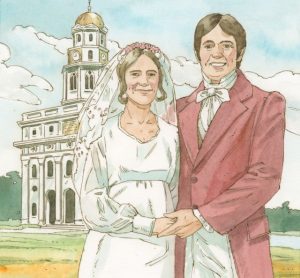
Joseph Smith asked the Lord some questions about marriage. Jesus told him that a man and woman should be married by a man who has the priesthood. They should be married in the temple. If they obey God’s commandments, they will be married forever. [D&C 132:1-29]
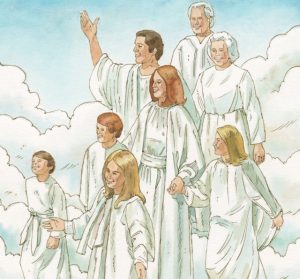
Righteous people who are married in the temple will live in the celestial kingdom of heaven. Their children who obey God will belong to them, and they will be an eternal family. They will live with God and will become like Him. [D&C 132:1-29]
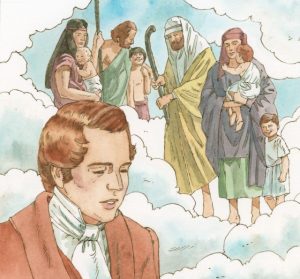
Jesus also told Joseph about the history of marriage among His people who lived anciently. [D&C 132:34-39]
That’s it. Three quick pictures. Not a word about polygamy. Nothing about the threats to destroy Emma. Really, though, I don’t blame the curriculum staff who put this together. It’s got to be a tough assignment to extract something that’s consistent with the Church’s current image of itself from that section.
I think D&C 132 should be discarded from our canon. I know the GAs like to refer to it to talk about the sealing power and eternal families (and maybe to hint about people becoming gods), but it’s awful that when they do so, they are also referring to language that openly describes women as property, and that threatens them with destruction if they don’t go along with their husband’s wishes to marry more wives. Unlike some other disturbing issues in Church history, like for example many aspects of Joseph Smith’s actual practice of polygamy, you don’t have to read any other sources to learn them. These disturbing things are written right there in our scriptures.
I understand that many or most GAs probably wouldn’t want to drop D&C 132, because they still believe in it, polygamy and woman-as-property and all. Clearly, though, that’s not the public face they want to present, what with their decades of downplaying polygamy. I wish they could get on board with not only appearing to be done with polygamy, but actually dropping it from our doctrine. I realize it would be a major change, especially given how many GAs are openly planning to be polygamous in the next life.
To illustrate just how bad D&C 132 is, I thought it might be interesting to see what I could come up with if I tried to write a children’s version of it that still follows the principle of simplifying language and extracting only main points, while at the same time actually hitting all the main points, rather than just the few that are compatible with 21st-century Mormonism. Here’s my attempt, including some crude attempts at images. (As you’ll see, I’ve borrowed the pictures from the Church’s existing Scripture Stories, with attempts at photoshopping in a few places.)
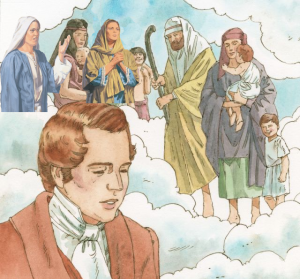
Joseph Smith asked the Lord some questions about marriage. He asked why some ancient prophets had been married to more than one wife. [D&C132:1]

Jesus told Joseph that he would answer his questions by teaching him a new and everlasting covenant. Jesus warned Joseph that anyone who learns of the covenant and doesn’t follow it cannot enter the celestial kingdom. [D&C 132:3-6]
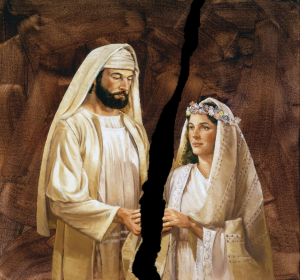
Jesus said that people’s marriages not by proper priesthood authority will end at their death, and will no longer count in the next life. [D&C 132:7-15]
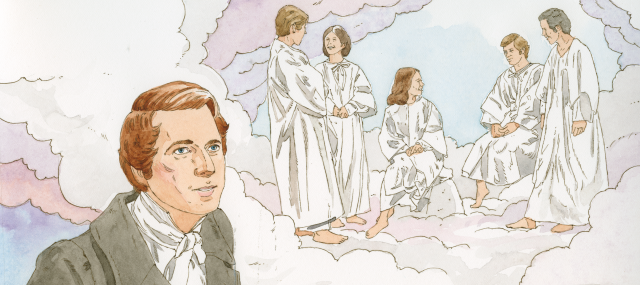
He said that these people will remain single in the next life, and will be servants of other people who were more righteous. [D&C 132:16-17]
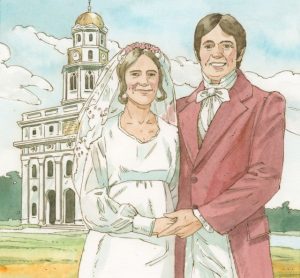
He said that people who are married by proper priesthood authority in the new and everlasting covenant and continue in the covenant will become like God in the next life. [D&C 132:19-20]
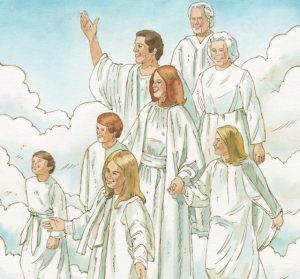
He said that if these people sin, so long as they don’t commit murder or deny the Holy Ghost, they will be punished by Satan for a time, but will enter the celestial kingdom eventually. [D&C 132:26-27]
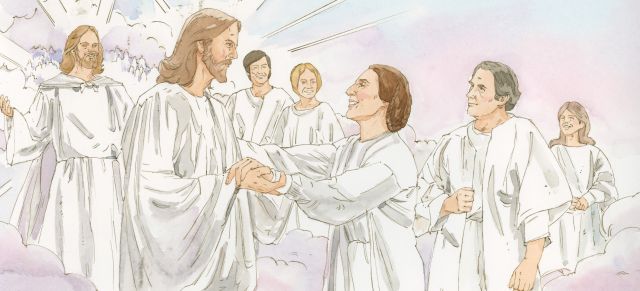
Abraham was one of the ancient prophets who had more than one wife that Joseph had asked about. Jesus said that Abraham was already in the celestial kingdom. [D&C 132:29]
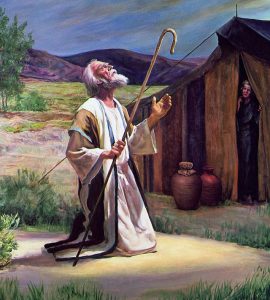
Jesus reminded Joseph of the promises he had made to Abraham, including that he would have a many descendants. He said that Abraham and other prophets had more than one wife to help them have many descendants. [D&C 132:34]
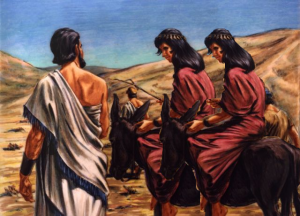
Jesus said that he had commanded the ancient prophets to have more than one wife. [D&C 132:35, 37-38]
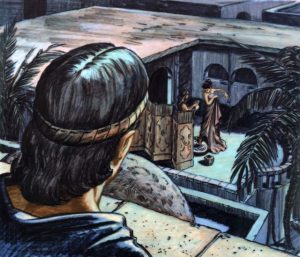
He said that King David had been righteous to have many wives, but he was wrong to have Uriah killed so he could have Bathsheba as a wife. [D&C 132:39]
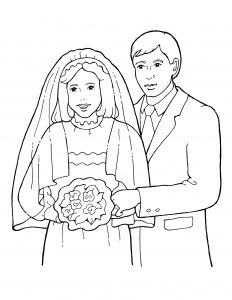 Jesus reminded Joseph that adultery is wrong. This means that if a man and a woman are married, neither of them should go be with another person. [D&C 132:41-43]
Jesus reminded Joseph that adultery is wrong. This means that if a man and a woman are married, neither of them should go be with another person. [D&C 132:41-43]
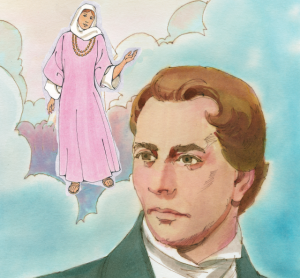
If a woman was accused of adultery, and she said she hadn’t done it, then Joseph would, by the power of the priesthood, decide if she was telling the truth. He would also tell who she should be married to. [D&C 132:44]
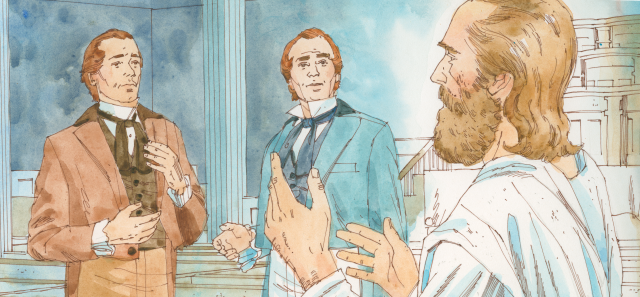
Jesus had given Joseph the sealing power, so anything he performed on earth, such as marriages, would continue in the next life. [D&C 132:45-48]
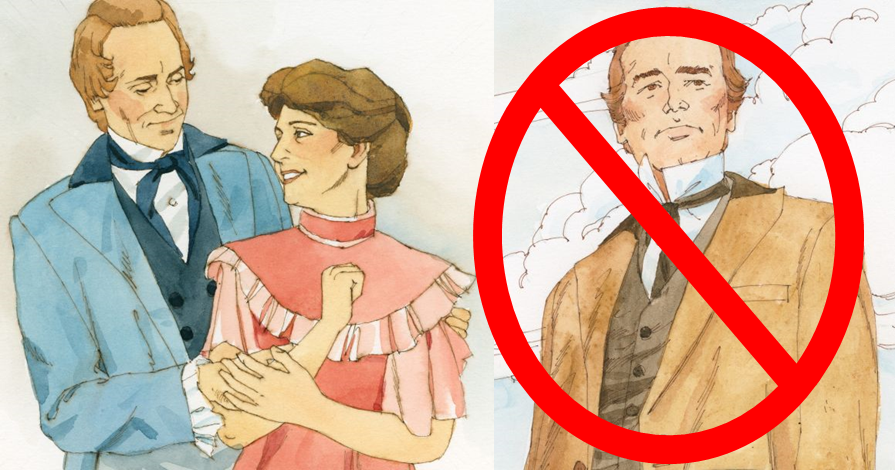
Jesus said he had commanded Joseph to offer another man to his first wife, Emma, but that she shouldn’t actually be with this other man. Jesus had been testing her, as he had tested Abraham when he told him to kill Isaac. [D&C 132:51]
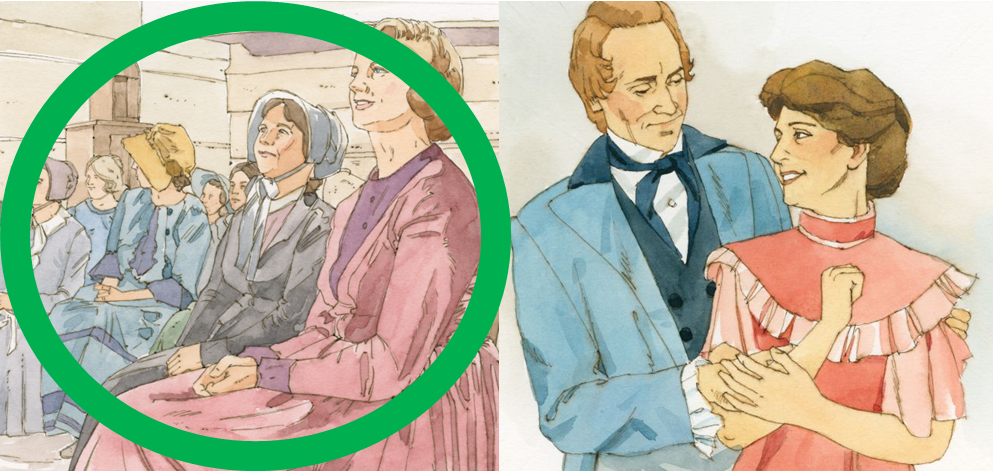
Jesus said that Emma should accept all the other wives that he had given to Joseph Smith. [D&C 132:52]
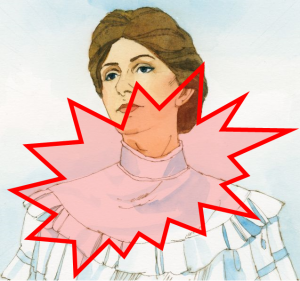
He said that if Emma didn’t stay with Joseph because of the other wives, she would be destroyed. If this happened, he would receive a much larger family, including many wives. [D&C 132:54-55]
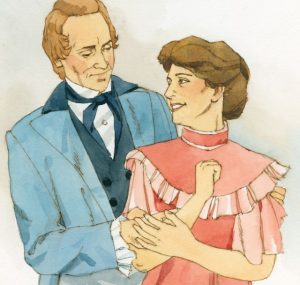
Jesus said Emma needed to forgive Joseph for things he had done wrong. [D&C 132:56]
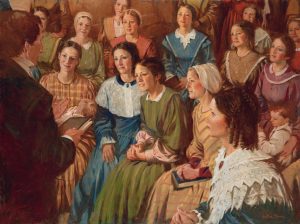
Jesus said if a man has one wife and wants to have more wives, and the first wife allows it, this is not adultery. The wives belong to him. [D&C 132:61-62]
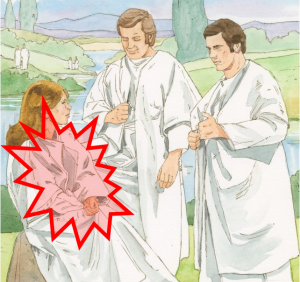
If a woman who is promised to a man as a wife goes to be with another man, she is committing adultery and she will be destroyed. [D&C 132:63]
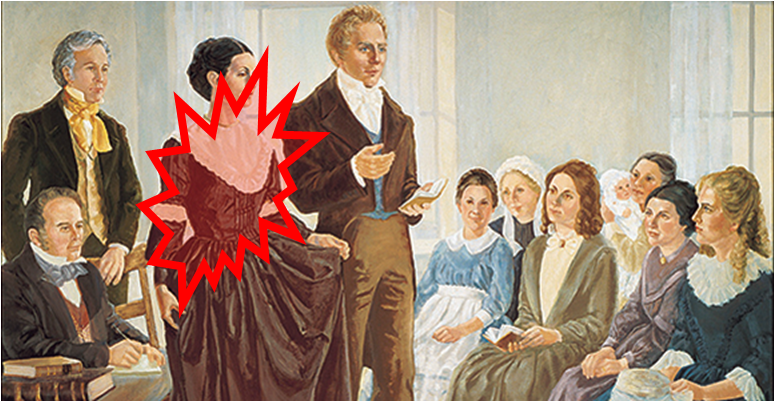
If a man’s wife does not consent to him marrying other wives, he no longer needs to get her consent to marry other wives, and she will be destroyed. [D&C 132:64-65]
Welp, that was horrifying.
I think I understand the thought behind this post, and in some ways your version *is* better — but in your zeal to be more frank, you’ve given far more detail than is necessary or desirable for children, even if the subject matter were child-friendly. Just as you don’t give a full sex talk to a child who asks where babies come from, even in simplified language, any scriptural lesson needs to be tailored to a child’s needs and comprehension. This isn’t it, I’m sorry.
Even if the Scripture Stories version were broader, its omissions are not as woefully destructive as the notion it teaches that “Righteous people who are married in the temple will live in the celestial kingdom of heaven.” It doesn’t take much effort to imagine children concluding, without discussion, that people who aren’t married cannot live in the celestial kingdom, and to personalize that by looking at people they know and thinking “Sister Parshall can’t go to heaven.”
Your version adjust this to say that “Joseph taught …” that people who are not married in the temple, including single people who never had a change to marry at all, will be servants to more righteous people. There we are again with the inevitable conclusion that “Sister Parshall isn’t righteous and can only go to heaven to work for better people.”
That is far from the most troublesome aspect of Sec. 132, of course, but it’s the one that jumps out at me every time marriage is discussed in any Church context. I don’t believe that to be single is to be unrighteous, and that single people can’t go to the celestial kingdom, or even that they might be able to go there but only as servants. I don’t think the Church teaches that — the Church doesn’t teach anything at all in this regard. It teaches the goal of temple marriage, assumes everybody worth their salt will find a way to marry in the temple (and *stay* married, when they really have no control over a spouse’s choices), and otherwise ignores single people, leaving us in limbo with no guidance for this life or specific hope for the next.
I don’t mind the continued canonization of Sec. 132; we have a lot of scripture that is not applicable today (ever worn a shirt made of mixed cotton and wool?). We do, however, need contextualization, and we need to NOT have Sec. 132 waved around for the few phrases we endorse and otherwise politely ignored.
/rant
Last time we did D&C 132 in Gospel Doctrine, I sat in the back of the classroom and listened silently as the teacher skipped all the troublesome verses. It was basically the same as the children’s book.
I don’t know how he could do differently because, if I recall correctly, the teachers manual said to avoid discussion of polygamy, as if not talking about it will make it go away. It is striking to me that the manual advises to avoid discussing the main point of the section.
Rockwell, exactly. If the manual says to avoid polygamy, that’s pretty much the whole section.
Ardis, I’m sorry this didn’t connect with you. I think your solution for that one point, to preface it with “Joseph taught,” could be a solution for the entire section. But I think that would go against how we generally frame scriptures, as being all from the lips of God.
hawkgrrrl, indeed.
I’m swaying between hilarious and horrifying! Well done!
Thanks, Di.
Also, Ardis, on further reflection, I think I understand your point about lack of context better. I think you’re right that in pushing back against the abstraction of everything away into high level in the existing book, I got overly literal and down in the weeds with this.
You may be reading my comment a little more negatively than I meant it. It’s a great exercise, merely a bit much for children — and it isn’t your fault that the attitude toward the single is what it is!
It might be a good exercise for anybody to do this kind of rewriting on any passage that is difficult (for any reason) –it would force us to take each part seriously and not skip from familiar line to familiar line, and we’d also have to be confident we understood it in order to simplify the language without wildly distorting the content.
I still think this is too much for any child, but this level of detail in simplified (non-scriptural, I mean; not dumbed down) language might actually be of great help to adults.
Yeah, I managed to stay very active while single, but as soon as the husband became much less abstract (and also isn’t a member), it became super clear that as far as the church is concerned, I’m still single. And therefore not a … well, an appendage to a real person (the highest a woman can aspire to, it seems).
If we’re going to excise parts of the D&C that we no longer embrace, we also need to tear a few pages from the Book of Mormon, which teaches doctrines the Church no longer believes.
I agree with Ardis that this is a good process for adults to go through with problematic passages. In this case, it does bring out how horrifying aspects of Section 132 really are. For me, how the text works to coerce Emma to accept Joseph Smith’s other wives with threats of destruction is particularly disturbing.
That bring said, I don’t know that I agree with the idea of de-canonizing the section. It’s a part of our history and our main glimps into how Joseph Smith understood and justified plural marriage. It’s also the key scriptural text for understanding temple sealings. (Though I’ll admit that I do think that, as said above, more context should be given, including a discussion of how we view things differently today).
Alternatively (musing and exploring options here), I wonder how possible it would be for current Church leaders to produce a document (whether a revelation or proclamation) that covers or reuses the things that are still important to us from this section, but in ways that are more in line with the modern Church, and then put it in the Doctrine and Covenants and relegate Section 132 to the Joseph Smith Papers Project for those who want to study it. The Family: A Proclamation to the World does a little of that, but not without its own problems and not in the same sense of outlining aspects of temple doctrine. It also doesn’t state the Church’s recent official adoption of the stance that monogamy is the general law and polygamy the exception. Working on such a document would also would be an opportunity to rethink how singles are viewed in our doctrine and, perhaps, be a bit more generous. Just a thought, though.
Also, I just have to say, Ziff, that the title of this post was one of the best hooks for drawing me in that I’ve seen in the bloggernacle in a long time.
Telling the old scripture stories simply to my children has brought many beautiful eternal truths home to me. This exercise seems to the the dark mirror of that, but in a way that is still useful.
I was surprised at Ardis’s reaction because I had assumed that this article/lesson was “for kids” only satirically, and I read it that way. I agree that I would never use it with my children. It seems to me so full of problematic issues that no single one stands out. Not because it was presented poorly, but because of the issues in the text itself. Where do I start?
-Polygamy, period.
-Women as property, to be given and taken.
-The idea of raising up more seed: it’s only that individual man who has more kids. Not the women, and not society, just that man. Children are seen as a reward and a trophy, even property, as much as wives.
-The promise of destruction if Emma/a wife does not agree, removing all agency. She has to just go with whatever her husband wants, or risk her marriage, her children, her economic viability, her standing in the community, and her eternal soul.
-The idea that a sealed couple is promised the celestial kingdom despite any sin short of murder. (Or denying the HG. But I am still not sure what that means.) Where is the incentive for doing the hard work of becoming more loving and Christlike? (Also, what about fraud, stealing, rape, abuse? A sealed person can do any of those things and after a few stripes enter the celestial kingdom and eventually become a God? If them, why not nearly anyone? If nearly anyone, why insist on this exclucivity?)
-The idea that people who aren’t in our religion or who did not marry will be our servants for eternity. That seams totally reasonable. I’d like two Catholics, a Buddhist and a Zoroastrian. Will 4 be enough to help with my large kingdom and brood?
-The idea that God would rip families apart without sealing. Or that sealing preserves the hierarchical order of families, “their children will always belong to them,” while being unsealed means we’re all just seperate and equal individuals. Both interpretations have issues.
-Joseph as judge and investigator of adultery (Wait, it only mentioned women. What about men?…No, that’s legit, he probably wouldn’t be a great judge of whether a man was adulterous.)
-Joseph can say whom should marry whom. Prophets get to dictate marrage partners. That doesn’t sound remotely cult-like or concerning.
-An Abrahamic test for Emma. First, really? Is that what a loving God or husband would do? And then, if she fails, that’s fine he’ll have a better family anyway. What?! (This one reminds me of the logic of abusers in setting up an impossible test, and if you pass the abuser wins and if you fail the abuser wins, but that might just be me.)
I won’t be reading this passage to my children. I am not sure if I’ll be reading D&C to them at all next year. We will see.
Great list, Hedwig. It’s definitely full of painful ideas.
Thanks for your comments, Chad. I’m glad you found the title tantalizing enough to come and read!
Wally, that’s a good point. De-canonizing would definitely open a can of worms in that once you de-canonize one thing, why not de-canonize others that don’t fit anymore? I don’t know that I have a good answer. D&C 132 seems like a good first candidate to me just because it has caused so much pain to so many of my family members and friends. But I realize actually doing something like that isn’t without its difficulties.
Olea, yeah. I’m sorry. I can see how it’s a punch in the gut.
Ardis, that’s a great point that something like this could be a useful exercise in a lot of passages. I’ve never actually gone to the trouble, but there have definitely been scriptures I’ve read where I thought, “I know what you’re getting at, but you need a better editor.”
Great post. Really great post. In teaching the section, many want to avoid the subject but also just find the language and length of the section somewhat impenetrable. Your post strips that away, and then shines a light on the content. With a children’s version (which many adults like for other scriptures), we are fully confronted with the basic principles of the section and all their issues. And we are confronted perhaps with how offensive we might see these principles being taught to our Sunbeam classes. And that is a valuable thought exercise. It also makes me think about what a different section 132 could have looked like—sealing power, and yes polygamy but some principles like section 121 and Proclamation on the Family. What that could have looked like…. Thanks again.
Thanks, Dub!
This is a well-done thought exercise into the basics in D&C 132. The way you write it really highlights the difficult parts. That section is so hard to read, the prose is so dense and difficult. It was nice to have some simple concepts pulled out and illustrated.
You know what I’ve always wondered about? Joseph says his motive for praying about marriage and getting this revelation was to ask about why Abraham, Isaac, Jacob, Moses, David and Solomon got to have “many wives and concubines.” D&C 132:1. Let’s just look at that in detail.
Abraham had one wife and one concubine. Sarai gave him Hagar so Abraham could have a son. Hagar was not a wife; she was a concubine. The resulting Ishmael/Isaac drama resulted in Hagar and Ishmael being banished. (After Sarai dies, Abraham married Keturah and has 6 more sons.)
Isaac actually only had one wife, Rebekah.
Jacob had two wives (Rachel and Leah) and two concubines (Zilpah and Bilhah). He played favorites and it caused so much hatred among his family that some of his sons sold his favorite son into slavery.
Moses had one wife, Zipporah.
David and Solomon filled their palaces with wives and concubines, and the Lord said that “was abominable before me.” Jacob 2:24.
Out of the six men named, two were NOT polygamists, and two were outright condemned as being abominable. Abraham fathered a baby on a servant who had no right to refuse him, and Jacob . . . much could be written about how badly Jacob’s refusal to even pretend to love his wives and sons equally affected that entire family. I don’t think Jacob wanted to be a polygamist. He loved Rachel and her two sons, and everyone else in that family knew Jacob would never love them like that.
Why would anyone look at those stories as something they wanted to do? It would be pretty easy to read about all that misery and think that the Lord was condemning men who wanted more than one wife/concubine. There was nothing holy or pure about polygamy at any time in scripture. It was something a culture allowed when men were on power trips (David and Solomon) or needed sons (Abraham) or got tricked (Jacob). Plural marriage in the scriptures always caused pain and family-wrecking trauma. To say that the Lord “justified” men in practicing polygamy is to ignore the fact that polygamy always led to miserable families. I cannot figure out why Joseph Smith wanted to know if he could be polygamous too. It must be about the sex and the number of babies a man can make, because polygamy sure isn’t about happiness for anyone involved.
Hi Melinda,
As to the number of wives of Moses, the section must be referring to Numbers 12:1. Some but not all commentators have historically interpreted this passage that the wife referred to here is not Zipporah, but another woman.
Dub, thanks for the reference. I stand corrected.
Melinda, I think you are absolutely correct. When I was at BYU I had an Art History professor who was a descendant of a polygamous family. It was a situation similar to Jacob. Her great grandfather loved the younger sister, but had to marry the older sister first. My professor was clear that no one was happy with the arrangement. Polygamy makes no sense.
We could revert the D&C? I’m sure Ardis could speak more eloquently to this as this is something I just learned this week, but the older versions of the D&C, specifically the ones published in the time frame of sect 132 did not have 132. Which makes a certain kind of sense, after all, all polygamy at this point was a secret. Publicly the church practiced one man/one woman marriage and had sect 111 delineating how it was solemnized. I don’t know if links work in comments, but this link is to the original section on marriage in the D&C, which is significant different than 132
https://www.josephsmithpapers.org/paper-summary/doctrine-and-covenants-1835/259
Interestingly Community of Christ ends up still using this section in the D&C since 132 was not added until the 1870’s and they don’t recognize its canonization.
The timing of this child’s version of 132 was interesting for me, having been thinking a lot about this section this week, having been learning about the history of it being canonized
This was eye opening for me. I need some clarification though. If it was arranged a woman would be married off to someone and she decided she wanted to break off that engagement and marry someone else according to D&C 132 she was commiting adultery?
Marie, that’s a good question. I honestly am not sure. Just the general tone of the section doesn’t seem to have much respect for women as agents, so from that I’d say yes.
Niki-La, good point. We could go back to the monogamy version, although then I guess we would lose the eternal marriage and becoming gods part that still get referred to. I mean, I’m saying that’s probably a reason GAs wouldn’t go for it.
Melinda, Dub, and Jason, thanks for the additional background on the OT people the section gestures at. Melinda, I think you make a great point that the portrayals of polygamy in the OT–written presumably by people who were familiar with it–sure doesn’t make it seem all that great.
A few comments and the article itself suggested “we” should get rid of Section 132. This is where I struggle. How is it possible that we should be able to pick and choose what in scripture we accept and what we don’t accept? Do we really get to decide what applies to us and what doesn’t? I just don’t buy it. It either is or it isn’t applicable to us. And if it isn’t applicable to us then it wouldn’t be scripture. And with so many things to be discarded how can any of it be held on to? It’s things like this that convince me more and more that while God does exist in some form, he doesn’t favor one people over another – there is no “true” church. He doesn’t give the answers to the test of life to only 16 million out of 7 billion people. What purpose would that serve a loving God? Why can’t the answer be that we’re all in the dark together in this mysterious mortal life? The only answers we have are the ones we choose to make us feel better, but in reality no one gets to cross the threshold of death with any more answers than anyone else. And isn’t that where we find the ultimate common ground and possibly our greatest comfort — knowing that not a single one of us really “knows” what lies beyond our life’s great pinnacle – death? We’re all in this together. We ought to try and live like we are. Walking hand in hand to the door and lovingly comforting one another as we place our hand on the knob and turn.